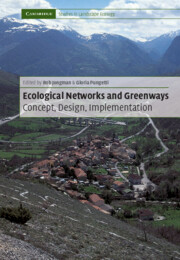Book contents
- Frontmatter
- Contents
- List of contributors
- Foreword
- Preface
- Acknowledgements
- 1 Introduction: ecological networks and greenways
- 2 The context and concept of ecological networks
- 3 Greenways in the USA: theory, trends and prospects
- 4 Ecological functioning of ecological networks: a species perspective
- 5 Impacts of roads on ecological networks and integration of conservation and transportation planning: Florida as a case study
- 6 Ecological corridors on a European scale: a typology and identification of target species
- 7 Planning the future landscape between nature and culture
- 8 From models to reality: design and implementation process
- 9 Design of the Pan-European Ecological Network: a national level attempt
- 10 Ecological ‘black spots’ within the ecological network: an improved design for rural road network amelioration
- 11 An ecological network for the Milan region based on focal species
- 12 Connecting corridors: implementing metropolitan greenway networks in North America
- 13 The Florida Statewide Greenways Project: its realisation and political context
- 14 The ecological network development in the Yungas, Argentina: planning, economic and social aspects
- 15 The river corridor of the Guadiamar
- 16 Conclusions: into the twenty-first century
- References
- Index
10 - Ecological ‘black spots’ within the ecological network: an improved design for rural road network amelioration
Published online by Cambridge University Press: 29 December 2009
- Frontmatter
- Contents
- List of contributors
- Foreword
- Preface
- Acknowledgements
- 1 Introduction: ecological networks and greenways
- 2 The context and concept of ecological networks
- 3 Greenways in the USA: theory, trends and prospects
- 4 Ecological functioning of ecological networks: a species perspective
- 5 Impacts of roads on ecological networks and integration of conservation and transportation planning: Florida as a case study
- 6 Ecological corridors on a European scale: a typology and identification of target species
- 7 Planning the future landscape between nature and culture
- 8 From models to reality: design and implementation process
- 9 Design of the Pan-European Ecological Network: a national level attempt
- 10 Ecological ‘black spots’ within the ecological network: an improved design for rural road network amelioration
- 11 An ecological network for the Milan region based on focal species
- 12 Connecting corridors: implementing metropolitan greenway networks in North America
- 13 The Florida Statewide Greenways Project: its realisation and political context
- 14 The ecological network development in the Yungas, Argentina: planning, economic and social aspects
- 15 The river corridor of the Guadiamar
- 16 Conclusions: into the twenty-first century
- References
- Index
Summary
Introduction
The presence of a well-developed road network in a region is a sine qua non for both economic development and efficient use of land resources (OECD 1986; Macpherson 1993; Tolley and Turton 1995; Jaarsma 1997). Rural road networks are planned to facilitate human movements.
Where there is fragmentation of habitat of both plant and animal populations, there is a need to facilitate movement of wildlife. For this purpose, ecological networks are planned. These networks are composed of core areas, buffer zones, and connecting ecological corridors (Jongman 1999). Ecological networks consist of large patches, which are the core areas, with surrounding buffer zones, mutually connected by long stretches of linear elements, which are the corridors (van Bohemen et al. 1991). Smith (1993) defines these corridors as ‘linear conservation areas’ or ‘greenways’. The term greenway has been applied to a wide range of landscape planning strategies, concepts, and plans. Nevertheless there is still little agreement on terminology (Ahern 1995). For this reason, within the context of this chapter, we use the term ecological network, according to Jongman (1999) and van Bohemen et al. (1991).
Well-known conflicts arise where the ecological networks and greenways meet human highways, where nature conservation conflicts with roads and the traffic they carry. Forman and Alexander (1998) and Spellerberg (1998) present surveys of the extensive literature in this field. Much of the research refers to the conflicts in the core areas and/or the conflicts with motorways.
- Type
- Chapter
- Information
- Ecological Networks and GreenwaysConcept, Design, Implementation, pp. 171 - 187Publisher: Cambridge University PressPrint publication year: 2004
- 2
- Cited by



